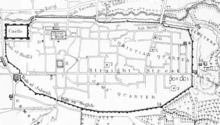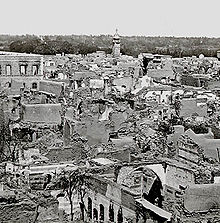Lazarist Monastery Damascus
The Lazarist Monastery of Damascus ( Arabic دير الآباء العازاريين), Monastery church also Al-Azarye-Church ( Lazarus- Church) or Al-Azaria-Church (كنيسة العازرية), is a monastery of the Roman Catholic Order of the Lazarists in the Syrian capital Damascus . It is located in the Christian quarter of the old town near the city gate Bāb Tūmā .
Location
The monastery stands south on the corner of Al-Azariya-Straße (Lazarusstraße, شارع العازرية) or Al-Azriya Alley (حارة العزرية) with Bāb-Tūmā Street (شارع باب توما) coming from Bāb Sharqi Street (شارع باب توما), the eastern part of Straight Street , to the north-eastern city gate Bāb Tūmā (Thomastorباب توما) leads. It stands between Bāb Tūmā Street in the west and Michael Naimy Street (حارة ميخائيل نعيمة) in the East. To the south of the monastery is also on Bāb-Tūmā Street, the St. George's Cathedral of the Syrian Orthodox Church of Antioch . On the north side of the opposite of the monastery is the Al-Azariah restaurant (مطعم العازرية).
history

In 1755, Lazarists from France opened the first mission school in Damascus, where they taught French, Latin, history, geography and Arabic. In 1783 the Lazarists in Damascus replaced the Jesuits , whose order had been dissolved by Pope Clement XIV in 1774 . According to the Handbook of Biblical Geography and Area Studies from 1844, the Lazarist monastery, in which French monks lived, was one of three Roman Catholic monasteries in Damascus, besides the Franciscan monastery and the Capuchin monastery , but only in the 1832 a single priest lived.
Around 1860, of the approximately 150,000 inhabitants of Damascus, over 100,000 were Muslim. In the course of the civil war in the Lebanon Mountains , the Christian district of Damascus was sacked by Druze militias on July 9, 1860 , and around 6,000 Christians from the city of Damascus, including 30 priests and three bishops, were murdered. The Emir Abd el-Kader intervened and brought several thousand Christians to the citadel of Damascus for protection , including the Lazarists in addition to the Jesuits and the Sisters of Mercy. However, the Lazarist monastery in Damascus was destroyed.
The school of the Lazarists was nationalized in 1967, but they were able to open a complementary school ( al-Fager ) in 1977 . This was still in operation in 1996 and mostly attended by Christian students. In 1996 five monks belonged to the community of Lazarists.
Individual evidence
- ↑ http://www.hot-map.com/de/damascus - German-language map of Damascus on Hot-Map.com, accessed on May 6, 2020.
- ↑ Al Azaria Church , on the map in: Alabrash Zahra (2019): Old Damascus Travel Industry and Patrimony. Journal of Hotel and Business Management, 8 (2), No. 195.
- ↑ Kanīsat al 'Āzirīyah. Geoview.info, with various Arabic and English spelling variants, accessed on May 6, 2020.
- ↑ Al-Azareia Restaurant. Love Damascus, bound card, accessed May 6, 2020.
- ↑ according to Google Maps , accessed on May 6, 2020. Also when searching for دير الآباء العازاريين (the monastery of the Lazarist Fathers), accessed on May 6, 2020.
- ↑ David Dean Commins: Islamic Reform. Politics and Social Change in Late Ottoman Syria. Oxford University Press, New York / Oxford 1990. p. 15.
- ^ A b Lazarists and Sisters of Charity in Syria . In: The Sign of God . Vinzentinische Nachrichten (VN) 66th Lazarists Austria, 1996.
- ↑ Lorenz Clemens Gratz: Handbuch der Biblischen Erd- und Länderkunde , 1844. S. 59.
- ↑ The forgotten massacre. The portal to the Catholic spiritual world, accessed on May 6, 2020.
Coordinates: 33 ° 30 ′ 40.1 ″ N , 36 ° 18 ′ 55.1 ″ E
